
Alepisaurus ferox, the long snouted lancetfish, longnose lancetfish, or cannibal fish, is a species of lancetfish found in the ocean depths down to 1,830 m (6,000 ft). This species grows to 215 cm (85 in) in total length and a weight of 9 kg (20 lb).

Sabertooth or sabretooth fish are small, fierce-looking deep-sea aulopiform fish comprising the family Evermannellidae. The family is small, with just eight species in three genera represented; they are distributed throughout tropical to subtropical waters of the Atlantic, Indian, and Pacific Oceans.
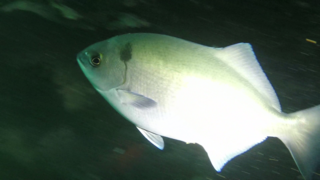
The halfmoon, also known as the blue perch, is a species of marine ray-finned fish, a sea chub from the subfamily Scorpidinae, part of the family Kyphosidae. It is native to the coasts of the eastern Pacific Ocean off western North America. It is fished for using hook and line and it is a desirable food fish.
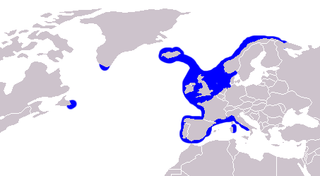
The common ling, also known as the white ling or simply the ling, is a large member of the family Lotidae, a group of cod-like fishes. It resembles the related rocklings, but it is much larger and has a single barbel. This species is unrelated to the pink ling, Genypterus blacodes, from the Southern Hemisphere. The common ling is found in the northern Atlantic, mainly off Europe, and into the Mediterranean Basin. It is an important quarry species for fisheries, especially in the northeastern Atlantic, although some doubts exist as to the sustainability of the fisheries. As an edible species, it is eaten fresh, frozen, or dried, but also preserved in lye, while the roe is a delicacy in Spain.

Slickheads, also known as nakedheads or smoothheads, are deep water fishes that belong to the family Alepocephalidae. They are most commonly found in the bathypelagic layer, which is approximately 3000m below the surface. They get their name from the lack of scales on their heads. Similarly, the scientific name is from the Greek ᾰ̓- (a-, "not"); λέπος (lepos, "scale"); and κεφαλή (kephalē, "head"). It has about 22 genera with ca. 96 species. In Japanese they are known as Sekitori Iwashi (関取鰯, "Massive Sardine").
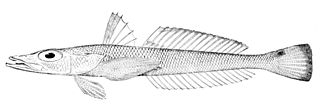
The Percophidae, duckbills, are a family of percomorph fishes, from the order Trachiniformes, found in tropical and subtropical waters of the Atlantic and Indian Oceans and in the southwestern and southeastern Pacific.

The sea toads and coffinfishes are a family of deep-sea anglerfishes known as the Chaunacidae.
This glossary of ichthyology is a list of definitions of terms and concepts used in ichthyology, the study of fishes.
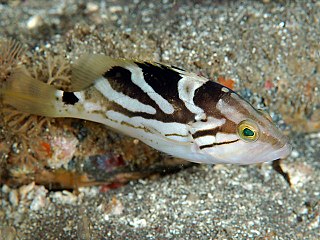
The comet grouper, also known as the comet cod or dot-dash grouper, is a species of marine ray-finned fish, a grouper from the subfamily Epinephelinae which is part of the family Serranidae, which also includes the anthias and sea basses. It is a species of deep coral reefs in the Indo-Pacific region.

Warming's lantern fish, Ceratoscopelus warmingii, is a lanternfish of the family Myctophidae, found circumglobally in both hemispheres, at depths of between 700 and 1,500 m during the day and between 20 and 200 m at night. Its length is about 8 cm (3.15 in).

The West African catshark is a catshark of the family Scyliorhinidae. It is found in the eastern Atlantic between latitudes 20° N and 17° S, at depths between 45 and 500 m. It can grow up to a length of 80 centimetres (31 in). At one time, the West African catshark was considered to be a subspecies of the nursehound, Scyliorhinus stellaris, but is now considered to be a separate species. The reproduction of this catshark is oviparous.

The boa catshark is a catshark of the family Scyliorhinidae. It is found on the continental shelves and insular slopes of the Caribbean Sea and the Gulf of Mexico, between latitudes 20° N and 9° N, at depths between 330 and 675 m. It can grow up to a length of 54 cm. The reproduction of this catshark is oviparous.

The Wonderfish (Thaumatichthys) is a genus of deep-sea anglerfish in the family Thaumatichthyidae, with three known species. Its scientific name means "wonder-fish" in Greek; oceanographer Anton Bruun described these fishes as "altogether one of the oddest creatures in the teeming variety of the fish world." In contrast to other anglerfishes, the bioluminescent lure of Thaumatichthys is located inside its cavernous mouth. They are worldwide in distribution and are ambush predators living near the ocean floor.
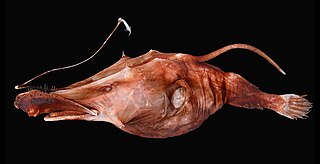
The Compleat Anglerfish (Lasiognathus) is a genus of deep-sea anglerfish in the family Thaumatichthyidae, with six species known from the Atlantic and Pacific Oceans. Its lure apparatus appears to consist of a fishing rod, a fishing line, bait, and hooks. It is also distinctive for an enormous upper jaw with premaxillaries that can be folded down to enclose the much shorter lower jaw.
The southern sennet is an ocean-going species of game fish in the barracuda family, Sphyraenidae. It was described by the Cuban zoologist Felipe Poey. The description was part of a two-volume work, which Poey published in 1860, entitled Historia Natural de la Isla de Cuba or Natural History of the Island of Cuba. Southern sennet are sometimes used as a food fish, and marketed either fresh or frozen. Although they are generally harmless, Southern sennet have been linked to ciguatera poisoning.
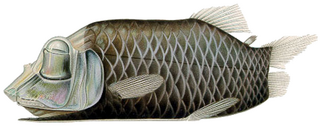
Opisthoproctus soleatus is a species of fish in the family Opisthoproctidae. It was first described in 1888 by Léon Vaillant. The species lives in most tropical seas, but is more common in the eastern Atlantic, from western Ireland to Mauritania and from Sierra Leone to Angola, and also in the South China Sea. O. soleatus can grow to a standard length of 10.5 centimetres (4.1 in) and usually live from about 500 to 700 metres deep.
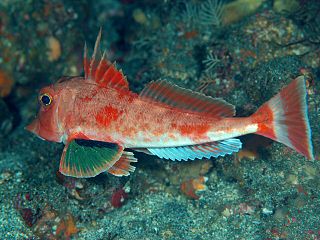
Lepidotrigla guentheri is a species of marine, demersal ray-finned fish from the family Triglidae, the gurnards and sea robins. It is found in the Northwestern Pacific Ocean.

Kyphosus bigibbus, the brown chub, grey drummer, darkfin drummer, insular rudderfish, grey chub, grey sea chub, southern drummer or topsail drummer is a species of marine ray-finned fish, a sea chub from the family Kyphosidae. It is a herbivorous species which is found in subtropical and tropical seas worldwide.

Sebastes ciliatus, the dusky rockfish, is a species of marine ray-finned fish belonging to the subfamily Sebastinae, the rockfishes, part of the family Scorpaenidae. It is typically found in the North Pacific Ocean, specifically in the Bering Sea near British Columbia, in the Gulf of Alaska, and in the depths of the Aleutian Islands.
Scopelarchus analis, the short fin pearleye, is a species of fish that can be found circumglobal in warm waters. It is a member of the Scoperlarchus, a genus of pearleyes.


















